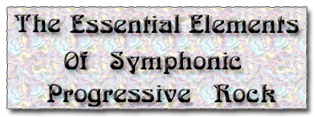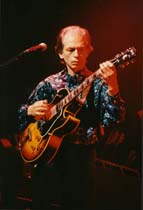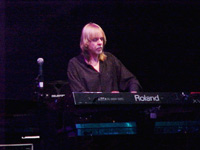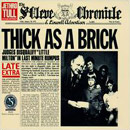by Tom Karr

Essential elements? Sez who? Me, that's who. What right do I have to say what is and is not progressive, or more precisely good symphonic progressive rock? Well ... none really, which puts me in the same boat as nearly every other writer on the subject. The people who could really say with any authority what and what is not good progressive rock are far too busy writing and performing it on stages around the world. So, we shall have to do the best we can absent their expert advice. Let's get on with the work then.
1- Symphonic progressive rock can be described as a foundation of psychedelic rock, from which it developed, overlaid and infused with generous portions of classical music, jazz, folk music, and various ethnic music styles, both current and long abandoned. Religious music, in its many forms also plays a large role in the genre known as progressive rock. This vast and diverse gene pool allows the composer virtually unlimited freedom of expression. Where some sub-genres of rock music confine the artists to what is, in effect, a tiny canvas, symphonic progressive music gives the songwriter the freedom to take their creations wherever their talent and vision leads them.
Along with the wide array of styles to draw upon, symphonic progressive rock bands also took some of the instruments common to other genres but alien to rock music. The flute is probably the most common non-rock instrument used in symphonic progressive, played most notably by Jethro Tull's Ian Anderson, Genesis vocalist Peter Gabriel, as well as Thijs Van Leer of Focus, to name but a few, and is heard in the music of a number of Italian bands such as PFM, Banco, Ezra Winston and many, many others. A number of other wind instruments such as oboe and bassoon make appearances from time to time, and a variety of horns, including trumpet, flugelhorn and even the krumhorn show up now and then, especially in the music of Gryphon.  Stringed instruments of all kinds are not uncommon in progressive rock, and at one point or another, Steve Howe of Yes can probably be heard playing most, if not all of them. A typical performance by Yes will feature Steve playing electric sitar, mandolin, what looks to me to be a lute, a dual neck pedal steel guitar and his usual collection of solid and hollow body guitars, acoustic and electric. Yes is not alone in showcasing a variety of instruments. The wonderful British group Gentle Giant featured five members, all of whom played several instruments on stage and in the studio. Cello, violin, xylophone, and vibraphone figured prominently in their music, and anyone lucky enough to have attended one of their live shows will remember the delight of seeing five extraordinary young men performing on five sets of amplified vibes.
Stringed instruments of all kinds are not uncommon in progressive rock, and at one point or another, Steve Howe of Yes can probably be heard playing most, if not all of them. A typical performance by Yes will feature Steve playing electric sitar, mandolin, what looks to me to be a lute, a dual neck pedal steel guitar and his usual collection of solid and hollow body guitars, acoustic and electric. Yes is not alone in showcasing a variety of instruments. The wonderful British group Gentle Giant featured five members, all of whom played several instruments on stage and in the studio. Cello, violin, xylophone, and vibraphone figured prominently in their music, and anyone lucky enough to have attended one of their live shows will remember the delight of seeing five extraordinary young men performing on five sets of amplified vibes.
2- Progressive rock is often a vehicle for musical virtuosity. This virtuosity need not be "in your face," and often it is not. A good phrase I have heard is that the difficulty of playing a complex passage is no longer an issue. The talents of the musicians can be displayed not only by the usual method familiar to any rock music listener, the solo, but by the composition itself. Difficult lines and melodies are often heard, and just as often, the technique and compositional abilities of the writers and players blend so well that the music may be first perceived as simple, when it is, in fact, quite demanding. And, as in any rock music, there can be found an abundance of solos and soloists, many very talented, and some who are, well?
Less commonly heard in popular rock music, but present in much of the best progressive rock, is contrapuntal melody. This term describes the combination of two or more melodies played simultaneously by a group of musicians. This may result in a passage that sounds quite complex, dissonant, or even atonal. On the other hand, the separate parts may sound very odd, heard alone, but may combine to produce an effect that sounds surprisingly simple, and belies the difficulty of the process and the skill involved.
At any rate, it is safe to say that progressive rock, good progressive rock anyway, will expose the listener to challenging and intriguing music and musicianship.
 I suppose that I would be remiss not to address, as every other writer has in their discussions of progressive rock's musical technique, the role of classical music training, or the self-taught facsimile of this education. Most progressive groups, certainly of the 1970s anyway, had at least one member who could claim some amount of classical music instruction, formal, as in the case of Yes's Rick Wakeman and Gentle Giant's Kerry Minear, or self-taught as in the case of ELP's Keith Emerson. Many of the less famous, though no less talented, keyboardists could find their way around a fugue or a toccata with little apparent difficulty. Yes, there were, and are still, many players of many instruments who could be used as examples of classical skills in progressive rock music. My emphasis on keyboards only reveals my own predilection. No slight is meant to the loyal fans of Steve Howe or Carl Palmer, to name but a few of the many educated non-keyboard players. I should like to point out that these two fine players took their musical education upon their own shoulders, hiring tutors, teaching themselves, and all of us in the process.
I suppose that I would be remiss not to address, as every other writer has in their discussions of progressive rock's musical technique, the role of classical music training, or the self-taught facsimile of this education. Most progressive groups, certainly of the 1970s anyway, had at least one member who could claim some amount of classical music instruction, formal, as in the case of Yes's Rick Wakeman and Gentle Giant's Kerry Minear, or self-taught as in the case of ELP's Keith Emerson. Many of the less famous, though no less talented, keyboardists could find their way around a fugue or a toccata with little apparent difficulty. Yes, there were, and are still, many players of many instruments who could be used as examples of classical skills in progressive rock music. My emphasis on keyboards only reveals my own predilection. No slight is meant to the loyal fans of Steve Howe or Carl Palmer, to name but a few of the many educated non-keyboard players. I should like to point out that these two fine players took their musical education upon their own shoulders, hiring tutors, teaching themselves, and all of us in the process.
3- Good progressive - and by that, I mean my favorites, of course, as well as a lot that I don't listen to - is often written and performed in unusual or odd time signatures or meter. Isn't this, then, an element of virtuosity, as covered above? Yes it is, but it is so distinct in its role in progressive rock music, that I think it should be considered apart from its mere requirement of technical skill. A drummer, for example, can consider playing in odd meter as so instinctual that he or she does not even consider unusual time signature as anything to be commented on. It is also true that for some listeners as well as musicians, the element of odd meter in progressive rock is an overlooked or unnoticed given, while a flashy guitar or keyboard solo is the real attention grabber.
All this said, for myself, and others, time signatures like 5/4, 7/8 or even more exotic forms such as 11/8 or 13/16 are a critical and indispensable element of truly exciting and fulfilling progressive rock music. And, in this area of musicianship and composing, progressive rock stands apart in stark contrast to most, if not all, other rock and popular music genres.
I cannot and have not, I hope, understated the importance of time signature as a defining element of progressive rock as a unique music form. I do not mean to say that no good music, in general, or progressive rock in particular, can utilize 4/4 time, but come on, haven't you heard enough 4/4 for a dozen lifetimes?
4- Song structure can be, and often is, unconventional. Anyone, musician or not, who knows the definitions of the words intro-verse-chorus and bridge can probably chart out the structure of 90% of the popular music of this and the last century. And the figure of 90% is likely far too generous. This common structure, with the dreaded 4/4 time signature, is the formula of nearly all the rock music we hear.
Breaking out of the confinement of conventional structure of intro-verse-chorus-verse-chorus-bridge, etc. is another of the crowning glories of good progressive rock music. The utilization of challenging arrangements and meter, as well as the combination of varying time signatures opens countless doors of creativity. Consider, for example, the brilliant structure of the Yes's "Heart Of The Sunrise" from their 1972 release Fragile. Please, let us have a moment of silence in honor of this seminal work?? Thank You.
This piéce de résistance features, within its first sixty seconds alone, a furiously played opening theme, or riff for those of us willing to admit ever listening to hard rock or metal, interpolating with dissonant lines of Hammond organ, a second theme introduced on bass guitar thirty seconds into the work, and a counterpoint chord progression performed on the Mellotron complementing the bass line. You get the idea, right?
This style of intricate, ever changing and evolving arrangement, utilizing multiple themes and stunning, exigent performance is another essential hallmark of worthwhile progressive rock.
5- The lyrical content of much of the symphonic rock I describe is in many, perhaps most, cases the antithesis of the typical rock and pop music subject matter. Frankly, I for one hold that odes to sex, chugging down liquor, cruising in your car and the joys of dancing are best left to, shall we say, other forms of music.
Furthermore, to strike while the iron is hot, let's outrage half the people reading this and say that the matter of lyrics or lyrical content, is, to me anyway, of only secondary importance. I would also like to take this opportunity to say that while most "music" writers would probably really like to be the literary critic for The New York Times, I, for one, strike out bravely and alone to say that the critical essence of progressive rock music is ... the music.
Ok, I'm sorry, really. On to the business at hand.
The lyrical content of much progressive rock music turns the eyes upward, toward semi-mystical experience or thought, and exploration of deep love, whether of our fellow humans or the earth and its creatures. This contrasts with the content of most of today's songwriters who would have us lock our attention firmly on our crotches (or theirs, for that matter). Lyrics dealing with topics of fantasy, magic and science fiction were and are popular. There are many fine examples of using this approach to deal with topical issues as well. Jon Anderson, for one, has addressed the war in Vietnam, through allusion and oblique references. I think? Ever the masters of (intentional?) misdirection, Yes' lyrics are renowned for the discussion and introspection they have generated among their legion of listeners. How can one dislike lyrics that allow the listener to project whatever interpretation they were predisposed to have?
Another approach to topicality and direct social commentary can be seen in the work of Ian Anderson of Jethro Tull. One of the most brilliant musical composers of the 1970s, he was capable of matching, and perhaps surpassing the best works of Yes at one moment, or the deified Lennon and McCartney at another moment. Ian Anderson took a completely different path in communicating his ideas to the listener than that followed by Jon Anderson. With Aqualung, gone is veiled reference, replaced by direct, cutting, straight talk. The more lyrically complex works that followed Aqualung utilize analogy and will remind the listener of the great English literature of the 18th and 19th century, but the clues as to the not too hidden meaning of these works are plentiful, and while it is still difficult to pin down the real intention and meaning of Yes' lyrics, even 35 years down the road, the meaning and message of  Thick As A Brick, and particularly A Passion Play are none too difficult to divine. He will always be known best for the music contained on these three album's, and focusing on the lyrical content of this string of intelligent and beautiful work, one will surely hear the words of a thoughtful yet deeply cynical observer of God and man. He was able to bring the listener along on his own journey through England and English class structure, shining a light on the pride and the prejudices of the day. To vastly, and probably foolishly, simplify the message that I took away from Mr. Anderson's song lyrics on these works, I hear his message as a call to show more charity and concern for the poor and downtrodden in our midst, and to worship the all-mighty by living up, as best we can, to the teachings of whoever it is we believe in, every day of the week, and not by merely being first in line at church on Sunday. Our legacy is what we create here on Earth, and we need to focus on the here and not the hereafter.
Thick As A Brick, and particularly A Passion Play are none too difficult to divine. He will always be known best for the music contained on these three album's, and focusing on the lyrical content of this string of intelligent and beautiful work, one will surely hear the words of a thoughtful yet deeply cynical observer of God and man. He was able to bring the listener along on his own journey through England and English class structure, shining a light on the pride and the prejudices of the day. To vastly, and probably foolishly, simplify the message that I took away from Mr. Anderson's song lyrics on these works, I hear his message as a call to show more charity and concern for the poor and downtrodden in our midst, and to worship the all-mighty by living up, as best we can, to the teachings of whoever it is we believe in, every day of the week, and not by merely being first in line at church on Sunday. Our legacy is what we create here on Earth, and we need to focus on the here and not the hereafter.
I cannot leave this discussion of lyrical content without admitting that progressive rock is not without its own pool of silly, shallow lyrics. Gong, for example, loved by many in the 1970s, were called the "pothead pixies" by some. The use of mind altering drugs was prevalent during the golden age of progressive rock, and this led to a fair amount of bizarre if not downright weird lyrics.
In conclusion, let me say that every time anyone attempts to define the essence of progressive rock they will, in the end, only succeed in defining what leads them to value one body of music rather than another, one era over another, one composer over another. I can no more list an immutable set of criteria for good symphonic rock, than I, or anyone else, can say with certainty what a great book is or what a fine painting looks like. My ideas of the essential elements of progressive rock music can only join with the numerous expositions of others to hopefully paint a picture that can be recognized by the music listener seeking to understand and add new meaning to the sounds he or she hears when listening to this music.
Copyright © by ProgressiveWorld.net All Right Reserved.
Published on: 2004-03-22 (18048 reads)

